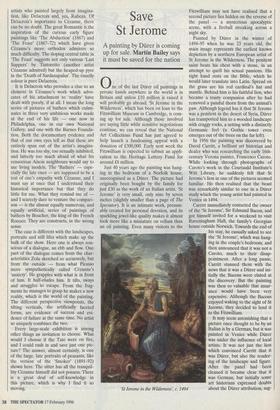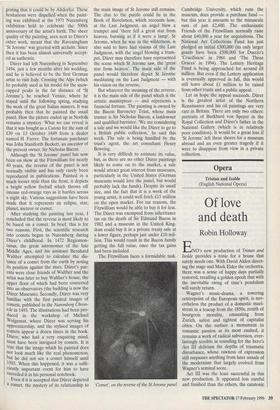Save St Jerome
A painting by Diirer is coming up for sale. Martin Bailey says it must be saved for the nation ne of the last Dflrer oil paintings in private hands anywhere in the world is in Britain and unless £10 million is raised it will probably go abroad. 'St Jerome in the Wilderness', which has been on loan to the Fitzwilliam Museum in Cambridge, is com- ing up for sale. Although those involved are saying little while sensitive negotiations continue, we can reveal that the National Art Collections Fund has just agreed to help launch a fundraising appeal with a donation of £300,000. Early next week the Fitzwilliam is expected to submit an appli- cation to the Heritage Lottery Fund for around £8 million.
Just 40 years ago the painting was hang- ing in the bedroom of a Norfolk house, unrecognised as a Diirer. The picture had originally been bought by the family for just £30 as the work of an Italian artist. 'St Jerome' is very small, only nine by seven inches (slightly smaller than a page of The Spectator). It is an intimate work, presum- ably created for personal devotion, and its sparkling jewel-like quality makes it almost look more like a miniature on vellum than an oil painting. Even many visitors to the `St Jerome in the Wilderness', c. 1494 Fitzwilliam may not have realised that a second picture lies hidden on the reverse of the panel — a mysterious apocalyptic scene, with a fireball streaking across a night sky.
Painted by Diirer in the winter of 1494-95 when he was 23 years old, the main image represents the earliest known depiction by a northern European artist of St Jerome in the Wilderness. The penitent saint beats his chest with a stone, in an attempt to quell his sexual passions. His right hand rests on the Bible, which he would later translate into Latin. Spread on the grass are his red cardinal's hat and mantle. Behind him is his faithful lion, who became a trusty companion after he had removed a painful thorn from the animal's paw. Although legend has it that St Jerome was a penitent in the desert of Syria, Diirer has transported him to a wooded landscape with craggy rocks, a setting with a distinctly Germanic feel (a Gothic tower even emerges out of the trees on the far left).
In 1956 the painting was discovered by David Carritt, a brilliant art historian and dealer who was researching the early 16th- century Verona painter, Francesco Caroto. While looking through photographs of Caroto's work in the Courtauld Institute's Witt Library, he suddenly felt that St Jerome's lion in one of the pictures seemed familiar. He then realised that the beast was remarkably similar to one in a Diirer study which the young artist had painted in Venice in 1494.
Carritt immediately contacted the owner of the 'St Jerome', Sir Edmund Bacon, and got himself invited for a weekend to visit Raveningham Hall, the family's Georgian house outside Norwich. Towards the end of his stay, he casually asked to see the 'St Jerome', which was hang- ing in the couple's bedroom, and then announced that it was not a Caroto, much to their disap- pointment. After a long pause, Carritt stunned them with the news that it was a Dilrer and ini- tially the Bacons were elated at the discovery. But the painting was then so valuable that insur- ance would have been very expensive. Although the Bacons enjoyed waking to the sight of St Jerome, they decided to lend it to the Fitzwilliam.
It may seem astonishing that a picture once thought to be by an Italian is by a German, but it was painted in Venice while Diirer was under the influence of local artists. It was not just the lion which convinced Carritt that it was Diirer, but also the render- ing of the landscape and figure. After the panel had been cleaned it became clear that it was German, but initially some art historians expressed doubts about the Darer attribution, sug- gesting that it could be by Altdorfer. These hesitations were dispelled when the paint- ing was exhibited at the 1971 Nuremberg exhibition held to celebrate the 500th anniversary of the artist's birth. The sheer quality of the painting, seen next to Diirer's other work, meant that the Raveningham `St Jerome' was greeted with acclaim. Since then it has been almost universally accept- ed as authentic.
Diirer had left Nuremberg in September 1494, just a few months after his wedding, and he is believed to be the first German artist to visit Italy. Crossing the Alps (which he probably used as his model for the snow- capped peaks in the far distance of `St Jerome), he reached Venice, where he stayed until the following spring, studying the work of the great Italian masters. It was probably then that he painted the small panel. How the picture ended up in Norfolk remains a mystery. What we can reveal is that it was bought as a Caroto for the sum of £30 on 13 October 1849 from a dealer named H. Farrer. The fortunate purchaser was John Staniforth Beckett, an ancestor of the present owner, Sir Nicholas Bacon. Although the `St Jerome' panel has now been on show at the Fitzwilliam for nearly 40 years, the reverse of the panel is not normally visible and has only rarely been reproduced in publications. Painted in a much looser style than the front, it depicts a bright yellow fireball which throws off intense red-orange rays as it hurtles across a night sky. Various suggestions have been made that it represents an eclipse, star, planet, meteor or comet.
After studying the painting last year, I concluded that the reverse is most likely to be based on a comet. In brief, this is for two reasons. First, the scientific research into comets began in Nuremberg during Diirer's childhood. In 1472 Regiomon- tanus, the great astronomer of the late Middle Ages, and his assistant Bernhard Walther attempted to calculate the dis- tance of a comet from the earth by noting its position against the stars. Diirer's par- ents were close friends of Walther and the artist was later to buy Walther's house, the Upper floor of which had been converted into an observatory (the building is now the Diirer Museum). Secondly, Diirer was very familiar with the first printed images of comets, published in the Nuremberg Chron- icle in 1493. The illustrations had been pro- duced in the workshop of Michael Wolgemut, where Darer was serving his apprenticeship, and the stylised images of comets appear a dozen times in the book. purer, who had a very enquiring mind, must have been intrigued by comets. It is true that the image which he painted does not look much like the real phenomenon, but he did not see a comet himself until 1503. When this happened, it was a suffi- ciently important event for him to have recorded it in his personal notebook. Even if it is accepted that Diirer depicted a comet, the mystery of its relationship to the main image of St Jerome still remains. The clue to the puzzle could lie in the Book of Revelation, which recounts how, at the Last Judgment, an angel blew a trumpet and 'there fell a great star from heaven, burning as if it were a lamp'. St Jerome, when he was in the wilderness, is also said to have had visions of the Last Judgment, with the angel blowing a trum- pet. Wirer may therefore have represented the scene which St Jerome saw, the 'great star from heaven'. The main side of the panel would therefore depict St Jerome meditating on the Last Judgment — with his vision on the reverse.
But whatever the meaning of the reverse, it is the main side of the panel which is the artistic masterpiece — and represents a financial fortune. The painting is owned by the Bacon Baronetcy Trust, whose main trustee is Sir Nicholas Bacon, a landowner and qualified barrister. 'We are considering a sale and we would like the Diirer to go to a British public collection,' he said this week. The sale is being handled by the trust's agent, the art consultant Henry Bowring.
It is very difficult to estimate its value, but, as there are no other Diirer paintings likely to come on to the market, a sale would attract great interest from museums, particularly in the United States (German museums would love the panel, but would probably lack the funds). Despite its small size, and the fact that it is a work of the young artist, it could well fetch £15 million on the open market. For tax reasons, the Fitzwilliam would be able to buy it for less. The Diirer was exempted from inheritance tax on the death of Sir Edmund Bacon in 1982 and a museum in the United King- dom could buy it in a private treaty sale at a lower figure, perhaps just under £10 mil- lion. This would result in the Bacon family getting the full value, once the tax gains had been included.
The Fitzwilliam faces a formidable task.
'Comet', on the reverse of the St Jerome panel Cambridge University, which runs the museum, does provide a purchase fund — but this year it amounts to the minuscule sum of just £2,600. The enthusiastic Friends of the Fitzwilliam normally raise about £40,000 a year for acquisitions. The National Art Collections Fund has just pledged an initial £300,000 (its only larger grants have been £500,000 for Duccio's 'Crucifixion' in 1984 and 'The Three Graces' in 1994). The Lottery Heritage Fund is being approached for around £8 million. But even if the Lottery application is eventually approved in full, this would still leave about £1 million to be raised from other trusts and a public appeal.
Let us hope the appeal succeeds. Diirer is the greatest artist of the Northern Renaissance and his oil paintings are very rare in Britain. There are only two others: portraits of Burkhard von Speyer in the Royal Collection and Diirer's father in the National Gallery (which is in relatively poor condition). It would be a great loss if `St Jerome' left these shores for a museum abroad and an even greater tragedy if it were to disappear from view in a private collection.



























































 Previous page
Previous page